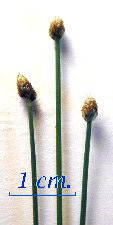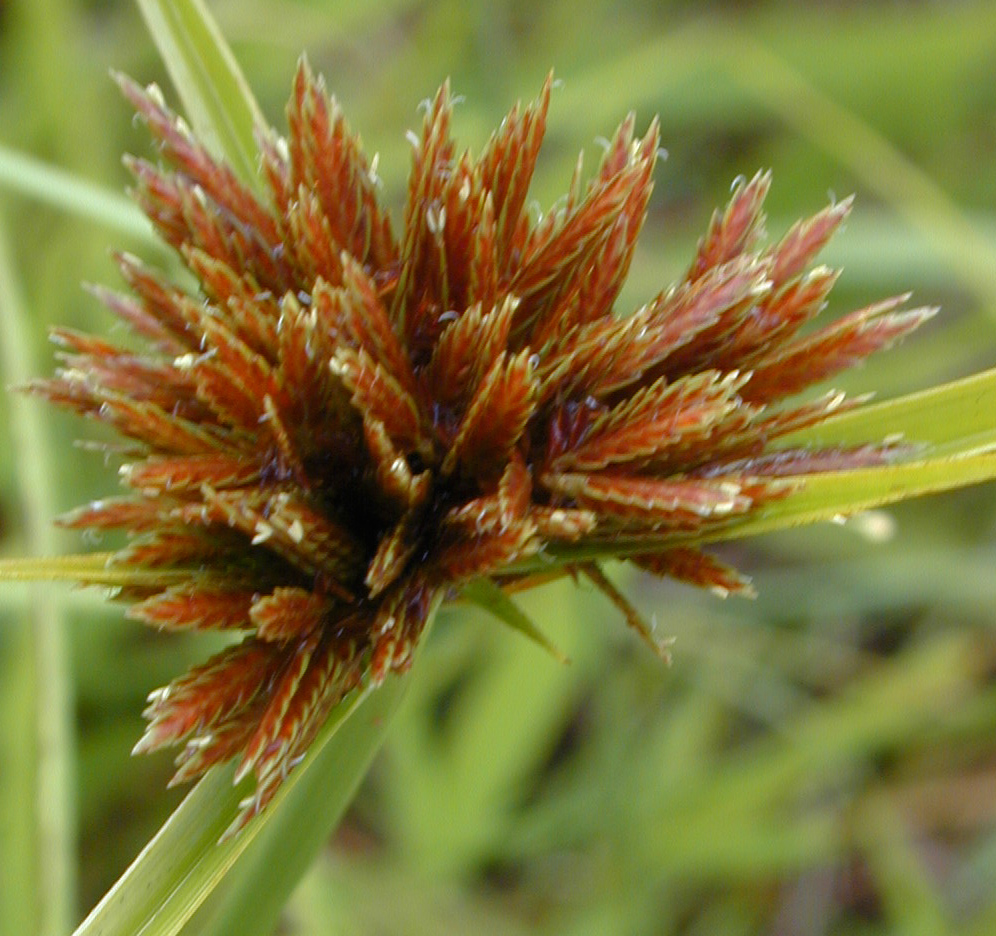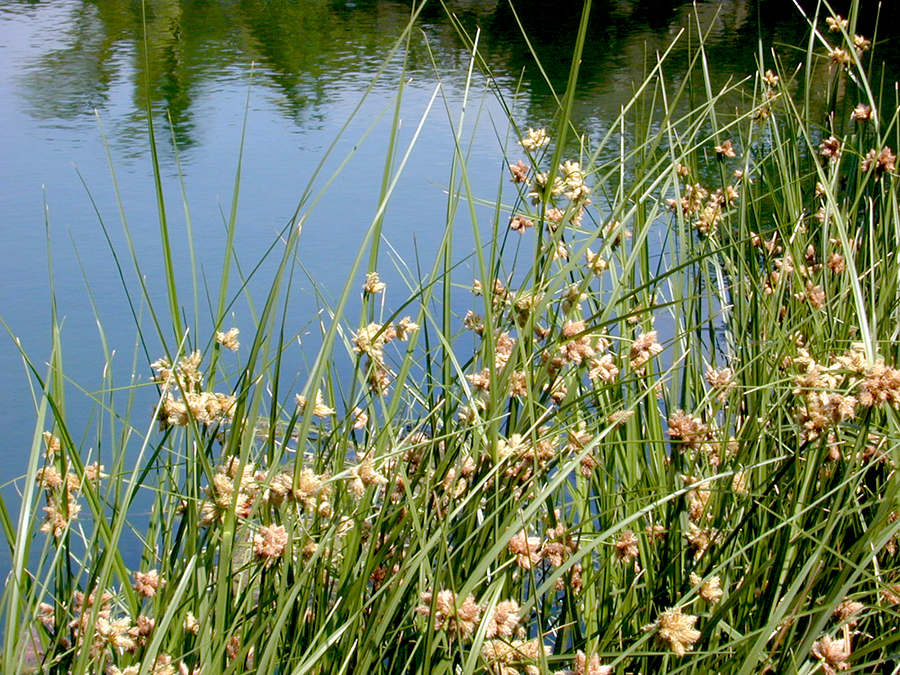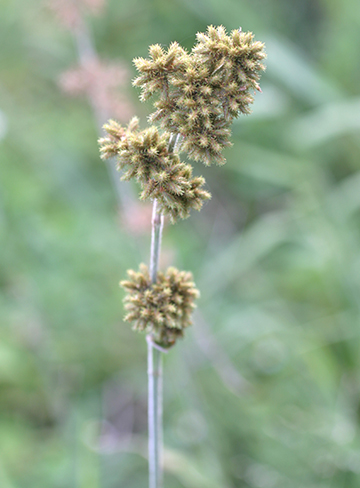|
[FAMILY CYPERACEAE]
|
|
|
|
|
9a
|
|
Plant a soft (spongy), green, vertical stem (culm) lacking leaves (basal sheath without blades may be present). Flower head or heads (inflorescence of spikelets) at or near top of stem, in some cases, with a conspicuous bract subtending (found directly below) the flower head, this bract appearing as an upward continuation of the culm. Rushes and some sedges .. .
|
|
[10]
|
|
|
9b
|
|
Stem (culm) clasped by one or more long, (cauline) narrow leaves OR culm with a basal rosette of linear leaves OR both. Usually leaf-like bracts occur directly below the inflorescence, although these may be very short or absent. Sedges .. .
|
|
[15]
|
|
~~~~ ~~~~~~~~~~~~~~~~~~~~~~~~~
|
|
10a |
(9) |
Multiple flower heads located at or below the tip of each mature culm, these sessile or on branches called rays. Culms usually greater than 1/8 in (3 mm) in diameter .. .
|
|
[11]
|
|
10b |
|
 A single, roughly ovoid (egg-shaped) flower head sessile and terminal on (capping) each mature stem (see Fig. 30B) OR without a terminating spikelet but producing viviparous plantlets at culm tip. Stems between 1 and 24 in (3 and 60 cm) tall, but very narrow (under 1/8 in or 2 mm). Spikerushes. Genus Eleocharis .. .
A single, roughly ovoid (egg-shaped) flower head sessile and terminal on (capping) each mature stem (see Fig. 30B) OR without a terminating spikelet but producing viviparous plantlets at culm tip. Stems between 1 and 24 in (3 and 60 cm) tall, but very narrow (under 1/8 in or 2 mm). Spikerushes. Genus Eleocharis .. .
Figure 30B. A spikerush (Eleocharis sp.) is characterized by a single
inflorescence set at tip of a narrow culm.
Consider Abildgaardia ovata, known as "one-spike fimbry".
|
|
[21]
|
|
~~~~ ~~~~~~~~~~~~~~~~~~~~~~~~~
|
|
11a
|
(10) |
Flower glumes (bract below each individual flower or floret) spirally arranged, so the spikelet is generally round in cross-section (ovoid to oblong in shape; see Fig, 30C, below); florets with bristles. Usually multiple flower heads located near tip of each mature culm and either sessile or borne on narrow rays. Culm either trigonous, terete, or pentagonal (three-sided or round or 5-6 sided in cross-section) Genus Schoenoplectus .. .
|
|
[12]
|
|
11b
|
|
Flower glumes two-ranked on spikelet, so the spikelet is flattened (see Fig. 30A above or Fig. 30D, below); flowers without bristles. Genus Cyperus (28 species in Hawai‘i; 20 species in the Marianas) .. .
|
|
[20]
|
|
~~~~ ~~~~~~~~~~~~~~~~~~~~~~~~~
|
|
15a
|
(9)
|
Culms solid (not hollow inside) and unbranched, three-sided or not; { plant otherwise not entirely as described in 15b .. .
|
|
[16] |
|
15b
|
|
Three-sided culms hollow and sometimes branched at lower nodes; leaves narrow, stiff and armed with exceptionally sharp edges ("saw-grass"); nut round in cross-section. { large marsh plants, typically 1 to 2 m (3 to 6 ft) or more in height, spreading by keikis that develop on the nodding floral culms. ‘Uki, saw-grass [HAW - IND] [OBL]Cladium jamaicense Crantz
|
|
|
~~~~ ~~~~~~~~~~~~~~~~~~~~~~~~~
|
|
16a
|
(15)
|
Spikelets many-flowered, glumes all similar (except first or first pair may be reduced and empty) .. .
|
|
[17] |
|
16b
|
|
Spikelets few-flowered, typically only 1 perfect flower per spikelet. Glumes of empty or staminate spikelets differ from those of perfect flowers (see Fig. M on page viii). Genus Scleria .. .
|
|
[20] |
|
~~~~ ~~~~~~~~~~~~~~~~~~~~~~~~~
[NOTE: THREE CHOICES HERE]
|
|
17a
|
(16)
|
 Floral bracts (scale covering flower parts) somewhat or distinctly folded along the center of each bract, and these arranged in two rows (2-ranked; see left, Fig. 30D and above, Fig. 30A) along the rachis of the spikelet. Genus Cyperus .. .
Figure 30D. Congested inflorscence of Cyperus polystachyos showing compressed (floral bracts folded, flattened), 2-ranked spikelets.
|
|
[23] |
|
|
17b
|
|
 Floral bracts subterete (oval in cross-section) , 2-ranked, often few in number .. . Floral bracts subterete (oval in cross-section) , 2-ranked, often few in number .. .
|
|
[19] |
|
|
17c
|
|
Floral bracts arranged spirally (not 2-ranked) around central axis (rachis) of spikelet, imbricate, the spikelet round or compressed (oval) in cross-section OR arrangement difficult to discern because flowers crowded within a dense, globose head (a spike) at top of culm .. .
|
|
(19) |
|
~~~~ ~~~~~~~~~~~~~~~~~~~~~~~~~
|
|
19a
|
(17)
|
Culm and leaf blades capillary, inrolled, culm 0.2-0.5 mm in diameter, blades about 0.2-0.3 mm wide. Spikelets few (2-7), some on rays, with 2-3 subtending, capillary bracts; spikelets under 1/8 in (3-4 mm). Achene (nut or fruit) with style base persisting at top. { Annual, tufted sedge 5 to 30 cm (2 to 12 in tall). Found in dry, open, sandy soil on Hawai‘i Island. [HAW - NAT] [UPL]Bulbostylis capillaris (L.) C.B. Clarke
|
|
|
|
19b
|
|
Leaves flat,or somewhat folded, but not capillary OR blade linear filiform and 0.5 to 2 mm in width. { Otherwise, plant not as described in 19a) .. .
|
|
(20) |
|
~~~~ ~~~~~~~~~~~~~~~~~~~~~~~~~
[NOTE: THREE CHOICES HERE]
|
|
20a
|
|
 Leaves basal and cauline, stiffly erect. Inflorescence a simple panicle of 1 - 4 short, unequal branches; spikelets ovoid to lanceolate (see Fig.s 30G and 30H, below), not flattened. Achenes brownish, compressed ovoid, smooth. { Perennial, tufted sedge 1 to 4 ft (0.5 to 1.5 m) tall. Found in fresh and saline coastal wetlands. Kaluhā, saltmarsh bulrush [HAW - IND] [OBL]
Leaves basal and cauline, stiffly erect. Inflorescence a simple panicle of 1 - 4 short, unequal branches; spikelets ovoid to lanceolate (see Fig.s 30G and 30H, below), not flattened. Achenes brownish, compressed ovoid, smooth. { Perennial, tufted sedge 1 to 4 ft (0.5 to 1.5 m) tall. Found in fresh and saline coastal wetlands. Kaluhā, saltmarsh bulrush [HAW - IND] [OBL]Bulboschoenus maritimus (L.) Palla paludosus (A. Nelson) T. Koyama
|
|
|
|
20b
|
|
Not exactly as above. Inflorescence paniculate or comprised of rays (narrow branches) off of top of culm, spikelets typically single at end of rays. Spikelets not flattened. Achenes trigonous (three-sided) or ovoid .. .
|
|
(21) |
|
20c
|
(19) |
Leaves mostly or all basal. Inflorescence a spike (tight cluster of spikelets) .. .
|
|
(23) |
|
~~~~ ~~~~~~~~~~~~~~~~~~~~~~~~~
|
|
21a
|
(20) |
Plant moderately large, rhizome short (clumping). Inflorescence of numerous, dark reddish brown spikelets. { Mesic to wet forest plants. Genus Machaerina .. .
|
|
[40] |
|
21b
|
|
Inflorescence of several to many spindle-shaped or globose spikelets. { small to moderately large sedges with short rhizomes. Not as above .. .
|
|
[22] |
|
~~~~ ~~~~~~~~~~~~~~~~~~~~~~~~~
|
|
22a
|
(21) |
 Plant moderately large to 1.5 m (~4 ft) tall, rhizome short. Culm leafy, typically pentagonal (5-sided), bluish-green in color. Inflorescence of multiple heads of several to many spikey, spindle-shaped spikelets. { Found in a variety of wet to mesic habitats, but not coastal swamps [GUM - IND] [OBL]
Plant moderately large to 1.5 m (~4 ft) tall, rhizome short. Culm leafy, typically pentagonal (5-sided), bluish-green in color. Inflorescence of multiple heads of several to many spikey, spindle-shaped spikelets. { Found in a variety of wet to mesic habitats, but not coastal swamps [GUM - IND] [OBL]
|
|
|
|
22b
|
|
Plant small to medium-sized (50 cm [1.5 ft] tall or less); if taller, spikelets brownish and not in congested spikes but attached at ends of rays (narrow branches). Genus Fimbristylis .. .
|
|
[30] |
|
~~~~ ~~~~~~~~~~~~~~~~~~~~~~~~~
|
|
23a
|
(20) |
Inflorescence a sessile spike (a tight cluster of numerous spikelets) .. .
|
|
[24] |
|
23b
|
|
Tufted perennial 40 to 70 cm tall. Inflorescence a single (rarely more) ovoid, sessile spikelet, 7-12 mm (1/4 to 1/2 in) long and slightly compressed. { Weedy plant in disturbed areas. [GUM - NAT] [FACW] Abildgaardia ovata (Burm. f.) Kral. Fimbristylis ovata of many authors. Consider also genus Eleocharis .
|
|
~~~~ ~~~~~~~~~~~~~~~~~~~~~~~~~
|
|
24a
|
(23) |
Inflorescence a single ovoid, sessile spike (white, green or, if dried, tan); spikelets bisexual, flattened laterally. Two stigmas per floret. Achenes lenticular. { small, weedy sedge in lawns and disturbed sites, spreading by creeping underground rhizomes. Genus Kyllinga .. .
|
|
[25] |
|
24b
|
|
Inflorescence a spike of various shapes. Spikelets unisexual with male (staminate) florets and female (pistillate) florets usually separated, but on the same individual (plant is monoecious). Achenes lenticular or trigonous. Genus Carex .. .
|
|
[30] |